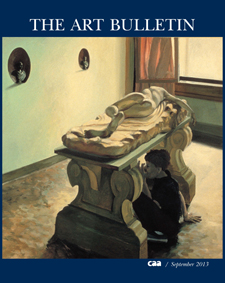CAA News Today
September 2013 Issue of The Art Bulletin
posted by Christopher Howard — Sep 13, 2013
 The September 2013 Art Bulletin, the leading publication of international art-historical scholarship, is the third issue of the journal’s centennial year. In the opening text, “Regarding Art and Art History,” David Summers traces his career as a trajectory of changing perspectives on art history. For the “Notes from the Field” section, eleven authors—Eric Fischl, Jan Assmann, Malcolm Bull, Darby English, Ludmilla Jordanova, Mary Miller, Steven Nelson, Ajay Sinha, Gloria Sutton, Gerrit Walczak, and David E. Wellbery—ponder the role of time in art. The September “Interview” features Partha Miller and Keith Moxey discussing the emergence of a world art history.
The September 2013 Art Bulletin, the leading publication of international art-historical scholarship, is the third issue of the journal’s centennial year. In the opening text, “Regarding Art and Art History,” David Summers traces his career as a trajectory of changing perspectives on art history. For the “Notes from the Field” section, eleven authors—Eric Fischl, Jan Assmann, Malcolm Bull, Darby English, Ludmilla Jordanova, Mary Miller, Steven Nelson, Ajay Sinha, Gloria Sutton, Gerrit Walczak, and David E. Wellbery—ponder the role of time in art. The September “Interview” features Partha Miller and Keith Moxey discussing the emergence of a world art history.
In his essay “Graphic Knowledge,” Peter Parshall analyzes Albrecht Dürer’s treatise on human proportion to reveal a fear of the transgressing power of imagination that, he argues, ultimately hobbled the artist and his legacy. Next, Matthew M. Reeve explores Horace Walpole’s neo-Gothic villa, Strawberry Hill, showing the role of the eighteenth-century Englishman’s sexuality in the design and reception of the house. In “Rhetorics of Place and Empire in the Fountain Sculpture of 1830s Havana,” Paul B. Niell examines the reconfiguration of international forms, iconography, and materials in three public fountains erected in Cuba during the 1830s to show how a burgeoning Atlantic world city negotiated its relation with the Spanish Empire and its emerging distinctiveness as a local setting. Finally, Namiko Kunimoto considers the Japanese artist Tanaka Atsuko’s Electric Dress in relation to a changing urban and industrial context in postwar Japan that provoked shifts in the status of gender, underscoring the frailty of female subjectivity.
In a “Centennial Review Essay,” H. Perry Chapman discusses what she calls the “problem with artists” by reconsidering two influential books: Ernst Kris and Otto Kurz’s Legend, Myth, and Magic in the Image of the Artist: A Historical Experiment (1934); and Rudolf Wittkower and Margot Wittkower’s Born under Saturn: The Character and Conduct of Artists; A Documented History from Antiquity to the French Revolution (1963). Then, Jacqueline E. Jung assesses Herbert L. Kessler and David Nirenberg’s edited volume, Judaism and Christian Art: Aesthetic Anxieties from the Catacombs to Colonialism, alongside Nina Rowe’s The Jew, the Cathedral, and the Medieval City: Synagoga and Ecclesia in the Thirteenth Century. Last, Peter Chametzky considers a recent exhibition and publishing project on a German art critic, which includes Konstanze Rudert’s catalogue, In the Network of Modernism: Kirchner, Braque, Kandinsky, and Klee … Richter, Bacon, Altenbourg, and Their Critic Will Grohmann, and Rudert and Volkmar Billig’s anthology, Will Grohmann: Texte zur Kunst der Moderne.
CAA sends The Art Bulletin to all institutional members and to those individuals who choose to receive the journal as a benefit of their membership. The next issue of the quarterly publication, to appear in December 2013, will feature essays on the artists Frederic Church and Awa Tsireh, Vasari’s alleged account of Roman Jews “adoring” Michelangelo’s Moses, and the contested status of color in Indian nationalism, among other topics.


